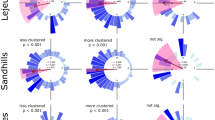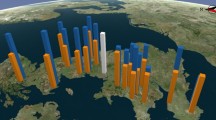Abstract
Bird nest orientation is affected by environmental variables determined by their geographical position as well as microclimatic conditions. In closed-cup-nesting species, nests may be oriented to avoid adverse environmental extremes such as sun exposure, wind, and rainfall, although vegetal cover may provide extra protection generating random orientation patterns. Here, we assess nest entrance orientation in Rufous Hornero (Furnarius rufus) at 11 South American sites by comparing nests well covered by vegetation (> 75% covered) from those with less or non-external vegetal protection (< 25%). We estimated and compared mean entrance orientation between northern and southern locations and levels of vegetation cover using circular statistics (n = 1291). Additionally, the influence of geographical latitude and vegetation cover on nest orientation was evaluated using linear mixed models across sites with non-random nest-orientation patterns. Results showed differences in mean orientation values between covered and uncovered nests at most locations and directed entrance orientation for uncovered nests. On the other hand, the models indicate that nest entrance orientation is not affected by the joint effect of latitude and vegetation cover and high variability between locations. Local microclimatic conditions provided by the vegetation above nests are important determinants for nest orientation in the species, although additional information about local rainfall, wind, temperature, and nesting site availability may help to determine the factors affecting orientation in the species on a local level.
Zusammenfassung
Der Einfluss der geographischen Breite und der Sonneneinstrahlung auf die Nestausrichtung bei Rosttöpfern (Furnarius rufus) Die Ausrichtung von Vogelnestern wird von Umweltvariablen beeinflusst, die durch die geographische Position der Nester sowie die dortigen mikroklimatischen Bedingungen bestimmt werden. Bei Arten, die in geschlossenen Napfnestern brüten, können die Nester so ausgerichtet sein, dass sie widrige Umweltextreme, z. B. bezüglich Sonneneinstrahlung, Wind und Regen, vermeiden, wobei die Vegetation zusätzlichen Schutz bieten und zu einer zufälligen Ausrichtung des Nesteingangs führen kann. Hier untersuchen wir die Ausrichtung des Nesteingangs bei Rosttöpfern (Furnarius rufus) an 11 südamerikanischen Standorten und vergleichen stark durch Vegetation geschützte Nester (> 75% bedeckt) mit solchen, denen die Vegetation nur wenig oder gar keinen Schutz bietet (< 25% bedeckt). Wir haben die mittlere Ausrichtung des Nesteingangs abgeschätzt und mit Hilfe von Kreisstatistik zwischen nördlichen und südlichen Standorten sowie Standorten mit unterschiedlicher Vegetationsbedeckung verglichen (n = 1291). Zusätzlich haben wir den Einfluss der geographischen Breite und der Vegetationsbedeckung auf die Nestausrichtung an Standorten, an denen die Nester nicht zufällig ausgerichtet waren, mit Hilfe linearer gemischter Modelle ausgewertet. Die Ergebnisse zeigten an den meisten Standorten Unterschiede in der mittleren Ausrichtung zwischen durch Vegetation geschützten und exponierten Nestern sowie eine gezielte Ausrichtung des Eingangs für exponierte Nester. Andererseits zeigen die Modelle, dass die Ausrichtung des Nesteingangs nicht durch den gemeinsamen Effekt von geographischer Breite und Vegetationsbedeckung beeinflusst wird und die Variabilität zwischen Standorten hoch ist. Die lokalen mikroklimatischen Bedingungen, die durch die über dem Nest befindliche Vegetation zustande kommen, sind wichtige Faktoren für Nestausrichtung bei dieser Vogelart, wobei zusätzliche Informationen über örtliche Regenfälle, Wind, Temperatur und Nistplatzverfügbarkeit dabei helfen dürften, die Faktoren zu ermitteln, welche die Nestausrichtung auf lokaler Ebene beeinflussen.



Similar content being viewed by others
References
Albano DJ (1992) Nesting mortality of Carolina Chickadees breeding in natural cavities. Condor 94:371–382
Ardia DR, Pérez JH, Clotfelter ED (2006) Nestbox orientation affects internal temperature and nest site selection by Tree Swallows. J Field Ornithol 77:339–344
Bates D, Maechler M, Bolker B, Walker S (2015) Fitting linear mixed-effects models using lme4. J Stat Softw 67:1–48
Bergin TM (1991) A comparison of goodness-of-fit tests for analysis of nest orientation in Western Kingbirds (Tyrannus verticalis). Condor 93:164–171
Brown M, Downs CT (2003) The role of shading behaviour in the thermoregulation of breeding Crowned Plovers (Vanellus coronatus). J Therm Biol 28:51–58
Burton NH (2006) Nest orientation and hatching success in the Tree Pipit Anthus trivialis. J Avian Biol 37:312–317
Burton NH (2007) Intraspecific latitudinal variation in nest orientation among ground-nesting passerines: a study using published data. Condor 109:441–446
Collias NE, Collias EC (1984) Nest building and bird behavior. Princeton University Press, Princeton
Conner RN (1975) Orientation of entrances to woodpecker nest cavities. Auk 92:371–374
Conway CJ, Martin TE (2000) Effects of ambient temperature on avian incubation behavior. Behav Ecol 11:178–188
Cook MI, Beissinger SR, Toranzos GA, Rodriguez RA, Arendt WJ (2003) Trans-shell infection by pathogenic micro-organisms reduces the shelf life of non-incubated bird’s eggs: a constraint on the onset of incubation? Proc R Soc Lond B 270:2233–2240
DuRant SE, Hopkins WA, Hepp GR, Walters JR (2013) Ecological, evolutionary, and conservation implications of incubation temperature-dependent phenotypes in birds. Biol Rev 88:499–509
eBird (2017) eBird: an online database of bird distribution and abundance [web application]. eBird, Ithaca. http://www.ebird.org. Accessed 8 July 2017
Evans SW (2017) The effect of nest site orientation on the breeding success of Blue Swallows Hirundo atrocaerulea in South Africa. Afr J Ecol 56:91–100
Facemire CF, Facemire ME, Facemire MC (1990) Wind as a factor in the orientation of entrances of Cactus Wren nests. Condor 92:1073–1075
Fox J, Weisberg S (2011) Multivariate linear models in R. An R companion to applied regression. Sage, Thousand Oaks
Fraga RM (1980) The breeding of Rufous Horneros (Furnarius rufus). Condor 82:58–68
Hanssen SA, Hasselquist D, Folstad I, Erikstad KE (2005) Cost of reproduction in a long-lived bird: incubation effort reduces immune function and future reproduction. Proc R Soc Lond B 272:1039–1046
Hartman CA, Oring LW (2003) Orientation and microclimate of Horned Lark nests: the importance of shade. Condor 105:158–163
Hoekman ST, Ball IJ, Fondell TF (2002) Grassland birds orient nests relative to nearby vegetation. Wilson Bull 114:450–456
Hooge PN, Stanback MT, Koenig WD (1999) Nest-site selection in the Acorn Woodpecker. Auk 116:45–54
Inouye DW (1976) Nonrandom orientation of entrance holes to woodpecker nests in aspen trees. Condor 78:101–102
Inouye RS, Huntly NJ, Inouye DW (1981) Non-random orientation of Gila Woodpecker nest entrances in saguaro cacti. Condor 83:88–89
Kovach Computing Services (2004) Oriana software. Version 2.0
Landler L, Jusino MA, Skelton J, Walters JR (2014) Global trends in woodpecker cavity entrance orientation: latitudinal and continental effects suggest regional climate influence. Acta Ornithol 49:257–266
Lloyd JD, Martin TE (2004) Nest-site preference and maternal effects on offspring growth. Behav Ecol 15:816–823
Mainwaring MC, Hartley IR (2013) The energetic costs of nest building in birds. Avian Biol Res 6:12–17
Mainwaring MC, Hartley IR, Lambrechts MM, Deeming DC (2014) The design and function of birds’ nests. Ecol Evol 4:3909–3928
Mainwaring MC, Barber I, Deeming DC, Pike DA, Roznik EA, Hartley IR (2016) Climate change and nesting behaviour in vertebrates: a review of the ecological threats and potential for adaptive responses. Biol Rev. https://doi.org/10.1111/brv.12317
Martin T, Roper J (1988) Nest predation and nest-site selection of a western population of the Hermit Thrush. Condor 90:51–57
Mezquida ET (2004) Nest site selection and nesting success of five species of passerines in a South American open Prosopis woodland. J Ornithol 145:16–22
Nelson KJ, Martin K (1999) Thermal aspects of nest-site location for Vesper Sparrows and Horned Larks in British Columbia. Stud Avian Biol 19:137–143
Norment CJ (1993) Nest-site characteristics and nest predation in Harris’ Sparrows and White-crowned Sparrows in the Northwest Territories, Canada. Auk 110:769–777
Peña MRDL (2005) Reproducción de las aves argentinas (con descripción de pichones). LOLA, Buenos Aires
Petersen KL, Best LB (1985) Nest-site selection by Sage Sparrows. Condor 87:217–221
R Core Team (2017) R: a language and environment for statistical computing. R Foundation for Statistical Computing, Vienna. https://www.R-project.org/
Rauter CM, Reyer HU, Bollmann K (2002) Selection through predation, snowfall and microclimate on nest-site preferences in the Water Pipit Anthus spinoletta. Ibis. 144:433–444
Ridgely RS, Tudor G (1994) The birds of South America. The suboscine passerines, vol II. University of Texas Press, Austin
Shibuya FL, Braga TV, Roper JJ (2015) The Rufous Hornero (Furnarius rufus) nest as an incubation chamber. J Therm Biol 47:7–12
Souza FL, Santos CA (2007) Climate and nest opening orientation in Furnarius rufus (Furnariidae). Iheringia 97:293–295
Tarvin KA, Smith KG (1995) Microhabitat factors influencing predation and success of suburban Blue Jay Cyanocitta cristata nests. J Avian Biol 26:296–304
Viñuela J, Sunyer C (1992) Nest orientation and hatching success of Black Kites Milvus migrans in Spain. Ibis 134:340–345
Visser ME, Lessells CM (2001) The costs of egg production and incubation in Great Tits (Parus major). Proc R Soc Lond B 268:1271–1277
Walsberg GE (1981) Nest-site selection and the radiative environment of the Warbling Vireo. Condor 83:86–88
Webb DR (1987) Thermal tolerance of avian embryos: a review. Condor 89:874–898
Webb DR, King JR (1983) An analysis of the heat budgets of the eggs and nest of the White-crowned Sparrow, Zonotrichia leucophrys, in relation to parental attentiveness. Physiol Zool 56:493–505
Wickham A (2011) The split-apply-combine strategy for data analysis. J Stat Softw 40:1–29
Wiebe KL (2001) Microclimate of tree cavity nests: is it important for reproductive success in Northern Flickers? Auk 118:412–421
With KA, Webb DR (1993) Microclimate of ground nests: the relative importance of radiative cover and wind breaks for three grassland species. Condor 95:401–413
Zar JH (1999) Biostatistical analysis. Prentice Hall, Upper Saddle River
Zuur AF, Ieno EN, Walker NJ, Saveliev AA, Smith GM (2009) Mixed effects models and extensions in ecology with R. Springer, New York
Zwartjes PW, Nordell SE (1998) Patterns of cavity-entrance orientation by Gilded Flickers (Colaptes chrysoides) in cardon cactus. Auk 115:119–126
Zyskowski K, Prum RO (1999) Phylogenetic analysis of the nest architecture of Neotropical ovenbirds (Furnariidae). Auk 116:891–911
Acknowledgments
We gratefully acknowledge Carlos Toscano-Gadea and Macarena Gonzalez for helping us with the fieldwork. We also thank Marisel Morales who kindly made the drawings, and Erica Cuyckens, who provided us with the map. Sebastian Kennerknecht is warmly thanked for helping to improve the English of the manuscript. Finally, we want to thank two anonymous reviewers for their detailed comments, which have greatly improved the quality of the manuscript. A. A. Schaaf, C.G. García, E. Tallei, and A. I. E. Quaglia hold doctoral grants provided by CONICET.
Author information
Authors and Affiliations
Corresponding author
Additional information
Communicated by T. Gottschalk.
Rights and permissions
About this article
Cite this article
Schaaf, A.A., García, C.G., Puechagut, P.B. et al. Effect of geographical latitude and sun exposure on Rufous Hornero (Furnarius rufus) nest orientation. J Ornithol 159, 967–974 (2018). https://doi.org/10.1007/s10336-018-1569-5
Received:
Revised:
Accepted:
Published:
Issue Date:
DOI: https://doi.org/10.1007/s10336-018-1569-5




